check engine light FIAT DOBLO COMBI 2012 Owner handbook (in English)
[x] Cancel search | Manufacturer: FIAT, Model Year: 2012, Model line: DOBLO COMBI, Model: FIAT DOBLO COMBI 2012Pages: 283, PDF Size: 6.31 MB
Page 206 of 283
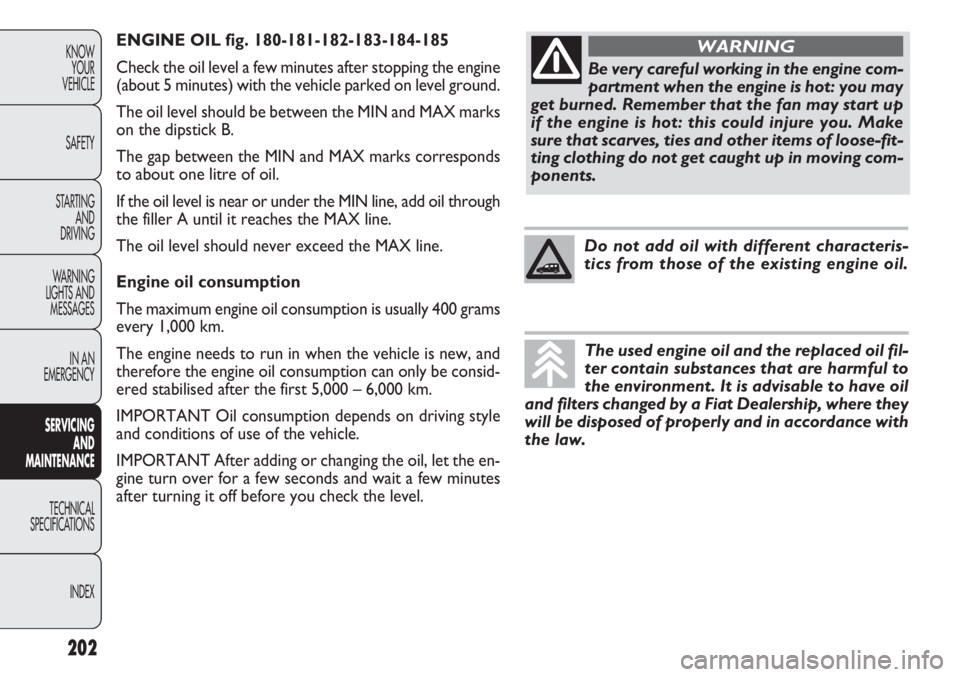
ENGINE OIL fig. 180-181-182-183-184-185
Check the oil level a few minutes after stopping the engine
(about 5 minutes) with the vehicle parked on level ground.
The oil level should be between the MIN and MAX marks
on the dipstick B.
The gap between the MIN and MAX marks corresponds
to about one litre of oil.
If the oil level is near or under the MIN line, add oil through
the filler A until it reaches the MAX line.
The oil level should never exceed the MAX line.
Engine oil consumption
The maximum engine oil consumption is usually 400 grams
every 1,000 km.
The engine needs to run in when the vehicle is new, and
therefore the engine oil consumption can only be consid-
ered stabilised after the first 5,000 – 6,000 km.
IMPORTANT Oil consumption depends on driving style
and conditions of use of the vehicle.
IMPORTANT After adding or changing the oil, let the en-
gine turn over for a few seconds and wait a few minutes
after turning it off before you check the level.
202
KNOWYOUR
VEHICLE
SAFETY
STARTING AND
DRIVING
WARNING
LIGHTS AND MESSAGES
IN AN
EMERGENCY
SERV IC
ING
AND
MAINTENANCE
TECHNICAL
SPECIFICA TIONS
INDEX
Be very careful working in the engine com-
partment when the engine is hot: you may
get burned. Remember that the fan may start up
if the engine is hot: this could injure you. Make
sure that scarves, ties and other items of loose-fit-
ting clothing do not get caught up in moving com-
ponents.
WARNING
Do not add oil with different characteris-
tics from those of the existing engine oil.
The used engine oil and the replaced oil fil-
ter contain substances that are harmful to
the environment. It is advisable to have oil
and filters changed by a Fiat Dealership, where they
will be disposed of properly and in accordance with
the law.
Page 207 of 283
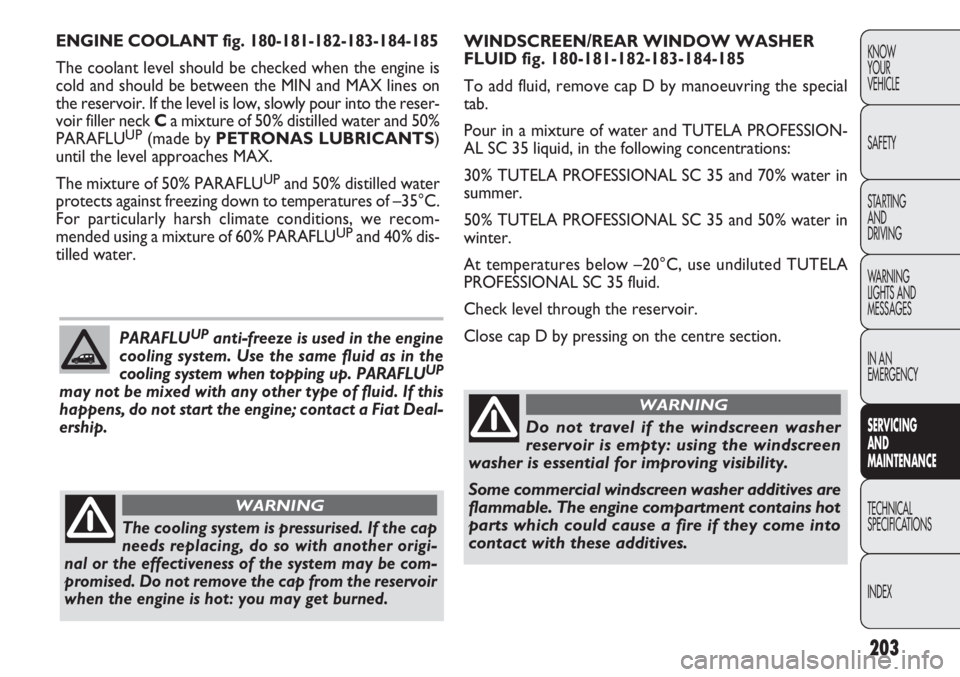
203
KNOW
YOUR
VEHICLE
SAFETY
STARTING
AND
DRIVING
WARNING
LIGHTS AND
MESSAGES
IN AN
EMERGENCY
SERVIC
ING
AND
MAINTENANCE
TECHNICAL
SPECIFICA TIONS
INDEX
WINDSCREEN/REAR WINDOW WASHER
FLUID fig. 180-181-182-183-184-185
To add fluid, remove cap D by manoeuvring the special
tab.
Pour in a mixture of water and TUTELA PROFESSION-
AL SC 35 liquid, in the following concentrations:
30% TUTELA PROFESSIONAL SC 35 and 70% water in
summer.
50% TUTELA PROFESSIONAL SC 35 and 50% water in
winter.
At temperatures below –20°C, use undiluted TUTELA
PROFESSIONAL SC 35 fluid.
Check level through the reservoir.
Close cap D by pressing on the centre section.
ENGINE COOLANT fig. 180-181-182-183-184-185
The coolant level should be checked when the engine is
cold and should be between the MIN and MAX lines on
the reservoir. If the level is low, slowly pour into the reser-
voir filler neck C
a mixture of 50% distilled water and 50%
PARAFLU
UP(made by PETRONAS LUBRICANTS )
until the level approaches MAX.
The mixture of 50% PARAFLU
UPand 50% distilled water
protects against freezing down to temperatures of –35°C.
For particularly harsh climate conditions, we recom-
mended using a mixture of 60% PARAFLU
UPand 40% dis-
tilled water.
PARAFLU
UPanti-freeze is used in the engine
cooling system. Use the same fluid as in the
cooling system when topping up. PARAFLU
UP
may not be mixed with any other type of fluid. If this
happens, do not start the engine; contact a Fiat Deal-
ership.
The cooling system is pressurised. If the cap
needs replacing, do so with another origi-
nal or the effectiveness of the system may be com-
promised. Do not remove the cap from the reservoir
when the engine is hot: you may get burned.
WARNING
Do not travel if the windscreen washer
reservoir is empty: using the windscreen
washer is essential for improving visibility.
Some commercial windscreen washer additives are
flammable. The engine compartment contains hot
parts which could cause a fire if they come into
contact with these additives.
WARNING
Page 209 of 283
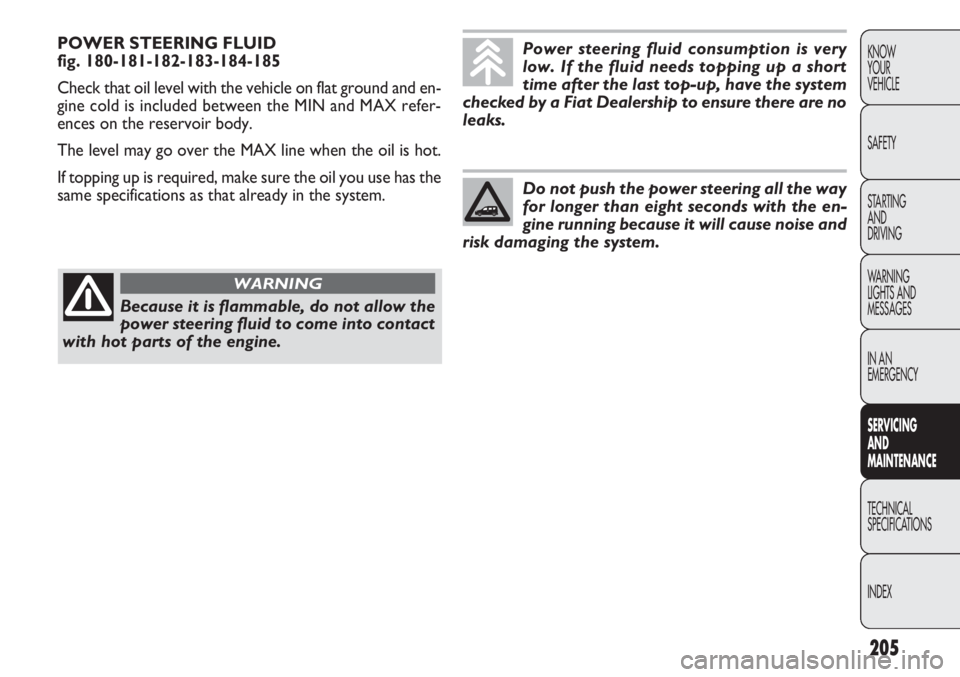
205
KNOW
YOUR
VEHICLE
SAFETY
STARTING
AND
DRIVING
WARNING
LIGHTS AND
MESSAGES
IN AN
EMERGENCY
SERVIC
ING
AND
MAINTENANCE
TECHNICAL
SPECIFICA TIONS
INDEX
POWER STEERING FLUID
fig. 180-181-182-183-184-185
Check that oil level with the vehicle on flat ground and en-
gine cold is included between the MIN and MAX refer-
ences on the reservoir body.
The level may go over the MAX line when the oil is hot.
If topping up is required, make sure the oil you use has the
same specifications as that already in the system.Power steering fluid consumption is very
low. If the fluid needs topping up a short
time after the last top-up, have the system
checked by a Fiat Dealership to ensure there are no
leaks.
Do not push the power steering all the way
for longer than eight seconds with the en-
gine running because it will cause noise and
risk damaging the system.
Because it is flammable, do not allow the
power steering fluid to come into contact
with hot parts of the engine.
WARNING
Page 210 of 283
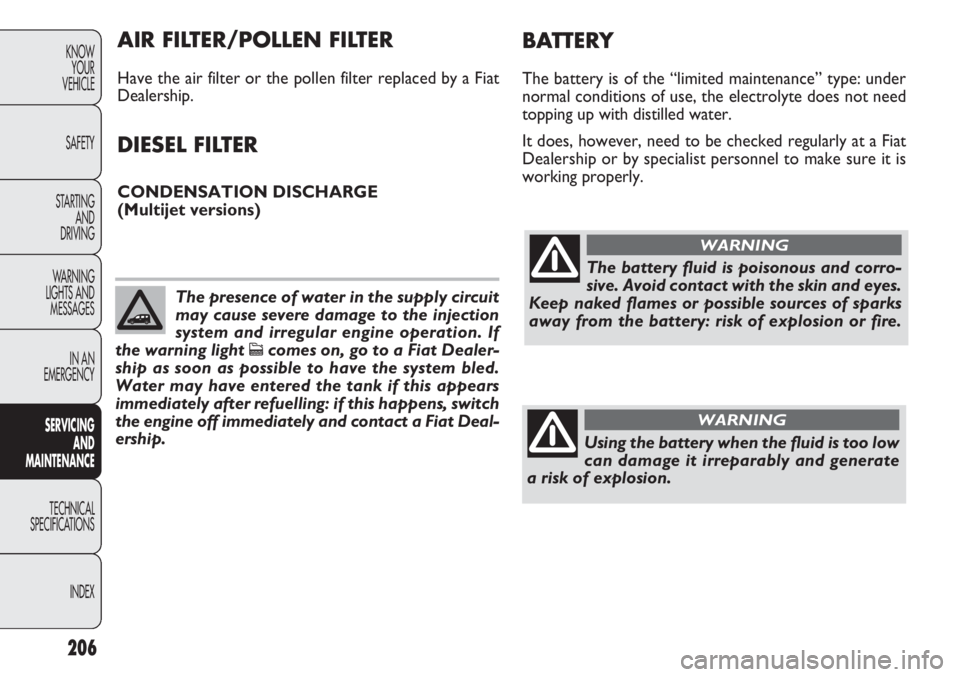
206
KNOWYOUR
VEHICLE
SAFETY
STARTING AND
DRIVING
WARNING
LIGHTS AND MESSAGES
IN AN
EMERGENCY
SERV IC
ING
AND
MAINTENANCE
TECHNICAL
SPECIFICA TIONS
INDEX
The battery fluid is poisonous and corro-
sive. Avoid contact with the skin and eyes.
Keep naked flames or possible sources of sparks
away from the battery: risk of explosion or fire.
WARNING
Using the battery when the fluid is too low
can damage it irreparably and generate
a risk of explosion.
WARNING
AIR FILTER/POLLEN FILTER
Have the air filter or the pollen filter replaced by a Fiat
Dealership.
DIESEL FILTER
CONDENSATION DISCHARGE
(Multijet versions)
BAT T ERY
The battery is of the “limited maintenance” type: under
normal conditions of use, the electrolyte does not need
topping up with distilled water.
It does, however, need to be checked regularly at a Fiat
Dealership or by specialist personnel to make sure it is
working properly.
The presence of water in the supply circuit
may cause severe damage to the injection
system and irregular engine operation. If
the warning light
ccomes on, go to a Fiat Dealer-
ship as soon as possible to have the system bled.
Water may have entered the tank if this appears
immediately after refuelling: if this happens, switch
the engine off immediately and contact a Fiat Deal-
ership.
Page 220 of 283
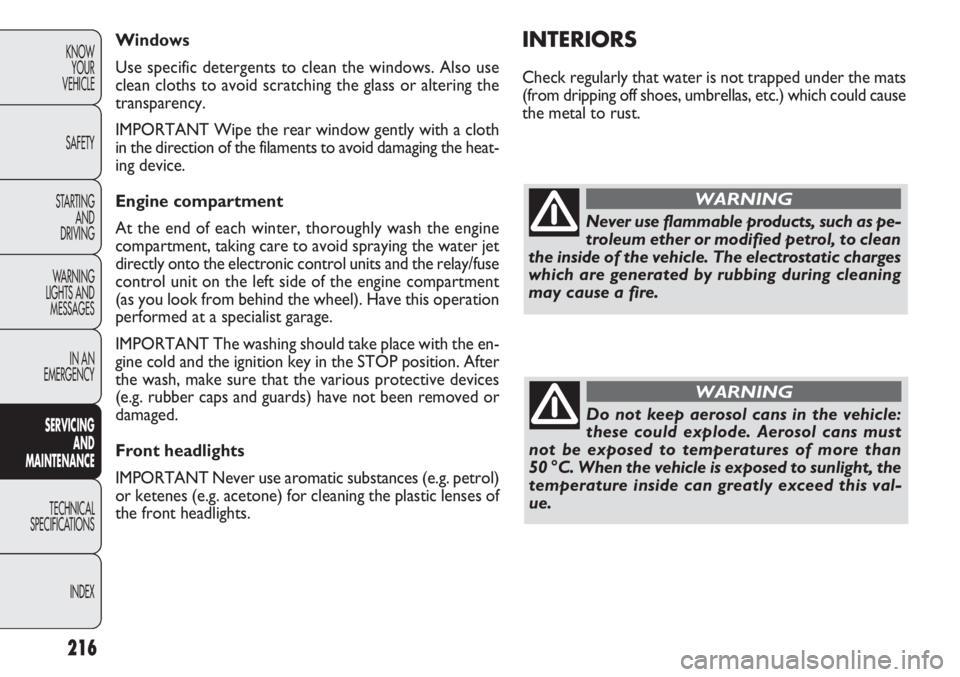
216
KNOWYOUR
VEHICLE
SAFETY
STARTING AND
DRIVING
WARNING
LIGHTS AND MESSAGES
IN AN
EMERGENCY
SERV IC
ING
AND
MAINTENANCE
TECHNICAL
SPECIFICA TIONS
INDEX
INTERIORS
Check regularly that water is not trapped under the mats
(from dripping off shoes, umbrellas, etc.) which could cause
the metal to rust.
Windows
Use specific detergents to clean the windows. Also use
clean cloths to avoid scratching the glass or altering the
transparency.
IMPORTANT Wipe the rear window gently with a cloth
in the direction of the filaments to avoid damaging the heat-
ing device.
Engine compartment
At the end of each winter, thoroughly wash the engine
compartment, taking care to avoid spraying the water jet
directly onto the electronic control units and the relay/fuse
control unit on the left side of the engine compartment
(as you look from behind the wheel). Have this operation
performed at a specialist garage.
IMPORTANT The washing should take place with the en-
gine cold and the ignition key in the STOP position. After
the wash, make sure that the various protective devices
(e.g. rubber caps and guards) have not been removed or
damaged.
Front headlights
IMPORTANT Never use aromatic substances (e.g. petrol)
or ketenes (e.g. acetone) for cleaning the plastic lenses of
the front headlights.
Never use flammable products, such as pe-
troleum ether or modified petrol, to clean
the inside of the vehicle. The electrostatic charges
which are generated by rubbing during cleaning
may cause a fire.
WARNING
Do not keep aerosol cans in the vehicle:
these could explode. Aerosol cans must
not be exposed to temperatures of more than
50 °C. When the vehicle is exposed to sunlight, the
temperature inside can greatly exceed this val-
ue.
WARNING
Page 254 of 283
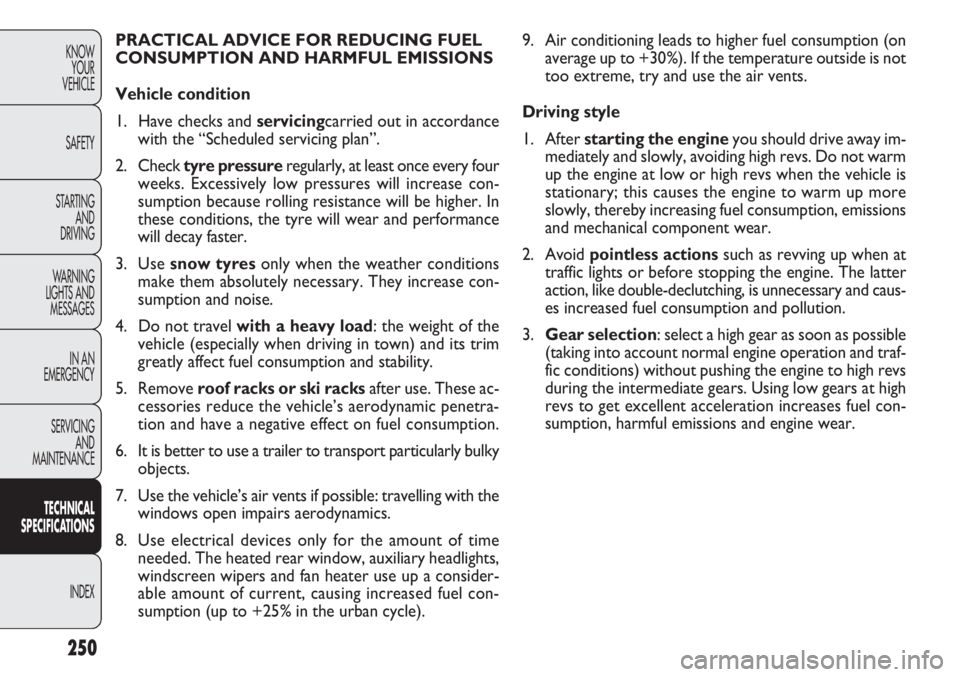
250
KNOWYOUR
VEHICLE
SAFETY
STARTING AND
DRIVING
WARNING
LIGHTS AND MESSAGES
IN AN
EMERGENCY
SERVICING AND
MAINTENANCE
TECHNICAL
SPECIFICAT IO
NS
INDEX
9. Air conditioning leads to higher fuel consumption (on average up to +30%). If the temperature outside is not
too extreme, try and use the air vents.
Driving style
1. After starting the engine you should drive away im-
mediately and slowly, avoiding high revs. Do not warm
up the engine at low or high revs when the vehicle is
stationary; this causes the engine to warm up more
slowly, thereby increasing fuel consumption, emissions
and mechanical component wear.
2. Avoid pointless actions such as revving up when at
traffic lights or before stopping the engine. The latter
action, like double-declutching, is unnecessary and caus-
es increased fuel consumption and pollution.
3. Gear selection: select a high gear as soon as possible
(taking into account normal engine operation and traf-
fic conditions) without pushing the engine to high revs
during the intermediate gears. Using low gears at high
revs to get excellent acceleration increases fuel con-
sumption, harmful emissions and engine wear.
PRACTICAL ADVICE FOR REDUCING FUEL
CONSUMPTION AND HARMFUL EMISSIONS
Vehicle condition
1. Have checks and
servicingcarried out in accordance
with the “Scheduled servicing plan”.
2. Check tyre pressure regularly, at least once every four
weeks. Excessively low pressures will increase con-
sumption because rolling resistance will be higher. In
these conditions, the tyre will wear and performance
will decay faster.
3. Use snow tyres only when the weather conditions
make them absolutely necessary. They increase con-
sumption and noise.
4. Do not travel with a heavy load: the weight of the
vehicle (especially when driving in town) and its trim
greatly affect fuel consumption and stability.
5. Remove roof racks or ski racks after use. These ac-
cessories reduce the vehicle’s aerodynamic penetra-
tion and have a negative effect on fuel consumption.
6. It is better to use a trailer to transport particularly bulky objects.
7. Use the vehicle’s air vents if possible: travelling with the windows open impairs aerodynamics.
8. Use electrical devices only for the amount of time needed. The heated rear window, auxiliary headlights,
windscreen wipers and fan heater use up a consider-
able amount of current, causing increased fuel con-
sumption (up to +25% in the urban cycle).
Page 272 of 283
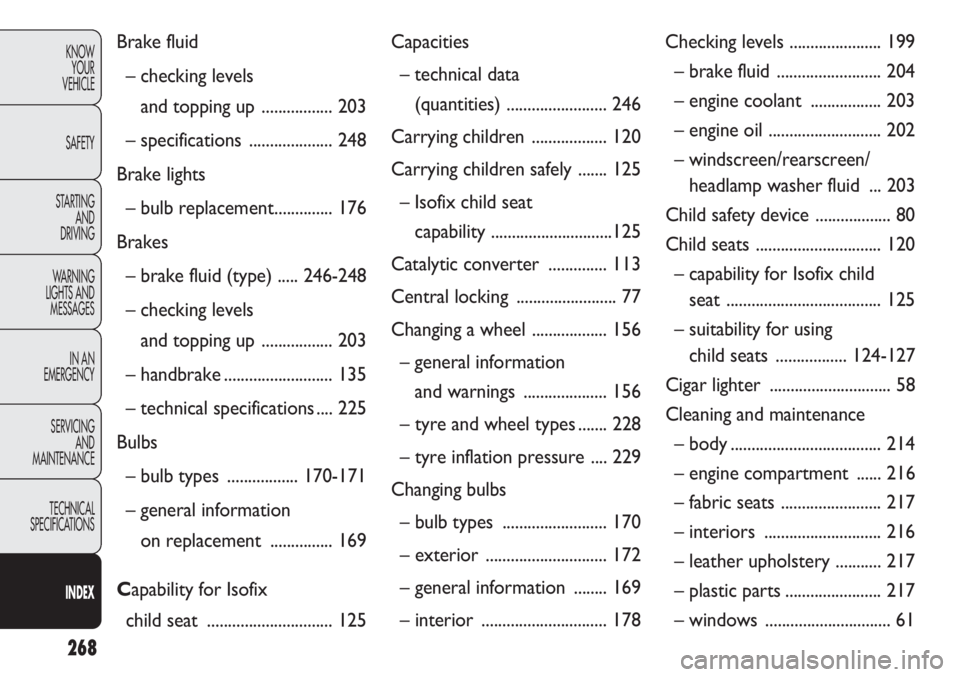
268
KNOWYOUR
VEHICLE
SAFETY
STARTING AND
DRIVING
WARNING
LIGHTS AND MESSAGES
IN AN
EMERGENCY
SERVICING AND
MAINTENANCE
TECHNICAL
SPECIFICATIONS
INDEXBrake fluid– checking levels and topping up ................. 203
– specifications .................... 248
Brake lights – bulb replace ment.............. 176
Brakes – brake fluid (type) ..... 246-248
– checking levels and topping up ................. 203
– handbrake .......................... 135
– technical specifications .... 225
Bulbs – bulb types ................. 170-171
– general information on replace ment ............... 169
C apability for Isofix
child seat .............................. 125 Capacities
– technical data (quantities) ........................ 246
Carrying children .................. 120
Carrying children safely ....... 125 – Isofix child seat capability .............................125
Catalytic converter .............. 113
Central lo cking ........................ 77
Changing a wheel .................. 156
– general information and warnings .................... 156
– tyre and wheel types ....... 228
– tyre inflation pressure .... 229
Changing bulbs – bulb types ......................... 170
– exterior ............................. 172
– general information ........ 169
– interio r .............................. 178 Checking le
vels ...................... 199
– brake fluid ......................... 204
– engine c oolant ................. 203
– engine oil ........................... 202
– windscreen/rearscreen/ headlamp washer fluid ... 203
Child safety device .................. 80
Child seats .............................. 120
– capability for Isofix child seat ..................................... 125
– suitability for using child seats .................124-127
Cigar ligh ter ............................. 58
Cleaning and maintenance – body .................................... 214
– engine compartment ...... 216
– fabric seats ........................ 217
– interio rs ............................ 216
– leather upho lstery ........... 217
– plastic parts ....................... 217
– windows .............................. 61
Page 274 of 283
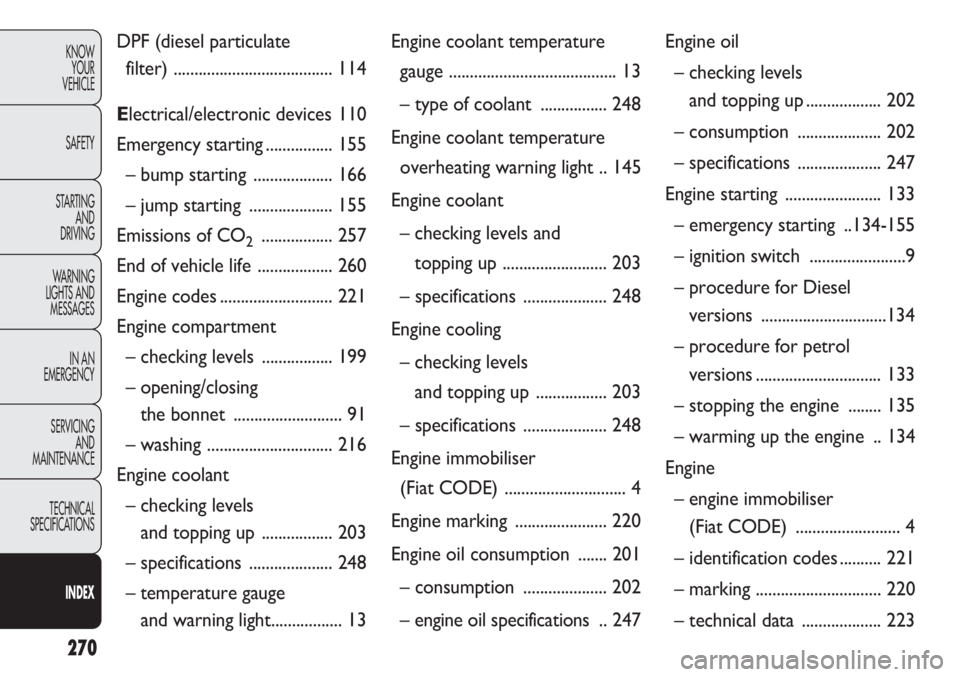
270
KNOWYOUR
VEHICLE
SAFETY
STARTING AND
DRIVING
WARNING
LIGHTS AND MESSAGES
IN AN
EMERGENCY
SERVICING AND
MAINTENANCE
TECHNICAL
SPECIFICATIONS
INDEXDPF (diesel particulate filter) ...................................... 114
E lectrical/electronic devices 110
Emergency starting ................ 155
– bump starting ................... 166
– jump starting .................... 155
Emissions of CO
2................. 257
End of vehicle life .................. 260
Engine codes ........................... 221
Engine compartment – checking le vels ................. 199
– opening/closing the bonnet .......................... 91
– washing .............................. 216
Engine coolant – checking levels and topping up ................. 203
– specifications .................... 248
– temperature gauge and warning light ................. 13Engine coolant temperature
gauge ........................................ 13
– type of coolant ................ 248
Engine coolant temperature overheating warning light .. 145
Engine coolant – checking levels and topping up ......................... 203
– specifications .................... 248
Engine cooling – checking levels and topping up ................. 203
– specifications .................... 248
Engine immobiliser (Fiat CODE) ............................. 4
Engine mark ing ...................... 220
Engine oil consumption ....... 201 – consumption .................... 202
– engine oil specifications .. 247 Engine oil
– checking levels and topping up .................. 202
– consumption .................... 202
– specifications .................... 247
Engine starting ....................... 133
– emergency starting ..134-155
– ignition switch .......................9
– procedure for Diesel versio ns ..............................134
– procedure for petrol versio ns .............................. 133
– stopping the engine ........ 135
– warming up the engine .. 134
Engine
– engine immobiliser (Fiat CODE) ......................... 4
– identification c odes .......... 221
– marking .............................. 220
– technical data ................... 223